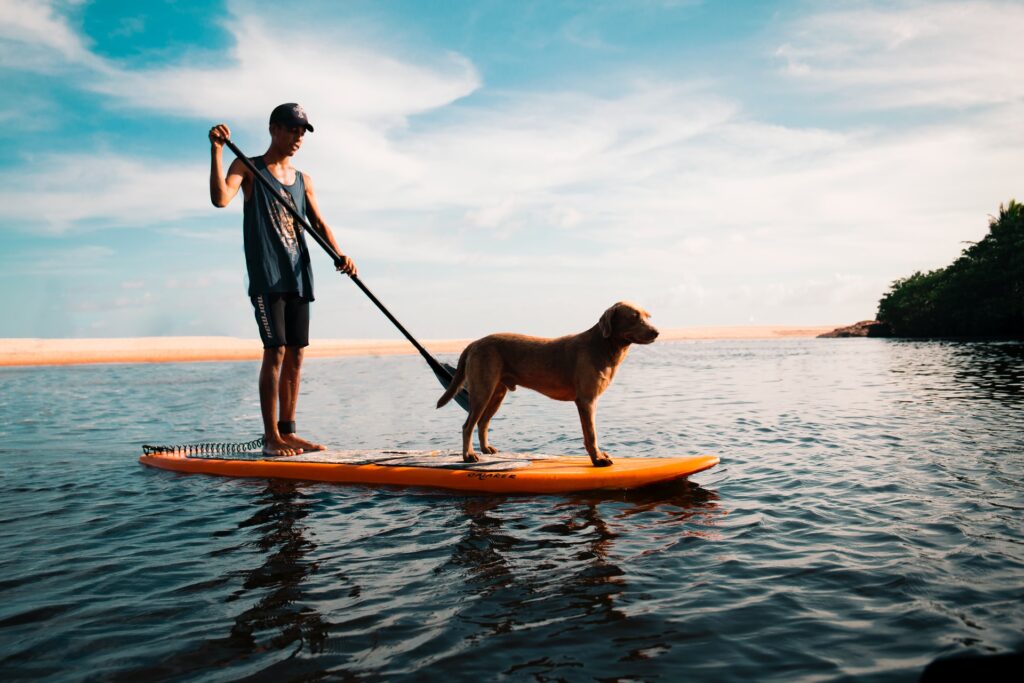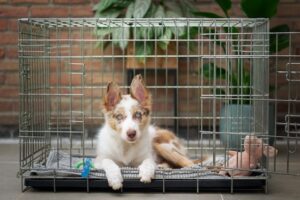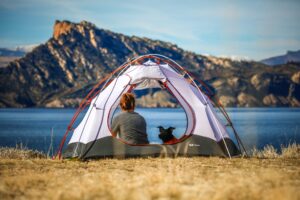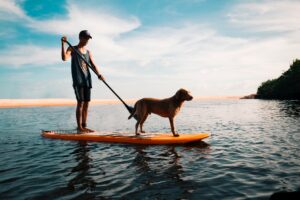Don’t you wish your pooch could come with you on all your adventures?
You’ve taken him for hikes, road trips, bike rides, and everywhere else. What if you could take him along on your next paddle boarding session?
Stand-up paddle board or SUP is a popular sport and activity. Not only does it help you escape into peaceful nature, but it is also a great way to get some exercise.
But wait. Is it safe to take your dog on a paddle board?
Totally!
Here’s why:
- Your pooch will have the time of his life when he is out in the open water.
- He will develop a stronger bond with you as he learns to trust you more.
- It will be a fun activity for him, even if he is not fond of swimming.
So how do you learn to paddle board with your dog?
This blog has you covered. Read along to find out everything you need to know.
What you need to paddle board with your dog
1. Stand up paddle board (SUP)
A canine-friendly SUP board is at least long and broad to accommodate dogs of all sizes and has plenty of space for them to move about.
Look for a board at least 10 feet long and 32 inches wide.
An inflatable paddle board is the better option for your pooch, as it is lightweight, portable, and offers great traction for Fido’s paws.
2. Personal flotation device (PFD)
A personal flotation device or life jacket is essential to keep your pup safe from any accidents that may result in drowning.
Even if you and your dog are excellent swimmers, it is recommended that both of you wear these life-savers when you go paddle boarding.
3. A bag of treats
Since paddle board is a new activity for your pooch, he needs to associate it with positive rewards. And there’s no better way than a bag of high-value treats!
Make sure to shower him with praises and offer plenty of treats as a reward every time he masters a step during his paddleboard training.
Introduce your dog to the paddleboard
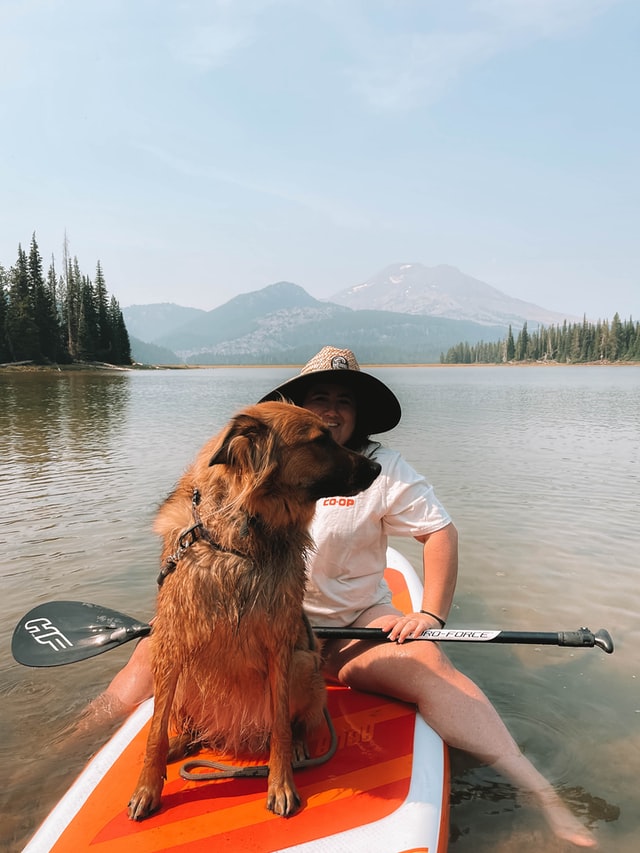
Your dog has to become comfortable with your paddleboard before going on adventures with you.
Bring your paddleboard inside the house and keep it in an area where you frequently play with your pooch. Encourage him to sniff it, climb on it, and get to know the large object.
Sit in the middle of the paddleboard with Fido’s favorite treats in your hand. Encourage him to come closer or sit with you, and reward him with the treat.
Soon your pup will become confident interacting with the board.
Practice with the paddleboard
It’s now time to move your paddleboard to the backyard. If you don’t have an open space, you can also make this work in a larger room in your house.
Your pooch will need to master the ‘stay’ command for this next step. This means he calmly stays in one spot and does not move until you ‘release’ him.
Once Fido is doing this, you’re good to go!
a) Getting on and off
Place the board on the ground. Grab a bag of dog treats and take your position at the center of the board. You can also stand on your knees to be closer to your pup.
Take a high-value treat in your hand and show it to him. Signal to him to come to get it.
Reward him with praises when he successfully climbs on the board and takes the treat from you. You can use the command ‘get on’ for this action.
Now make Fido’ sit’, ‘stand’, and ‘stay’ on the board. Soon he will be comfortable spending time on the board with you.
To teach him to get off, make your pooch stay on the board while standing or sitting.
Take another treat from the bag and stand a couple of feet away from the board. Show it to your pooch and ask him to come to get it.
When he climbs off the board, use the signal ‘get off.’
Repeat these commands until your dog has mastered them.
b) Standing and Paddling
Once your dog can spend a good amount of time calmly on the board, you can give him a glimpse of your adventures!
Stand on your knees in the middle of the board and ask Fido to ‘get on’. Make him sit or stand while facing you. Give him the ‘stay’ command once he has settled.
To start, rock the board side to side gently using your knees. If your pooch stays calm during this, use the paddle to do the rowing action. The goal here is to get your dog used to the board’s movements when it is in the water.
As he gets better at this, start doing this action while standing, and make him sit while facing away from you.
Put it into action
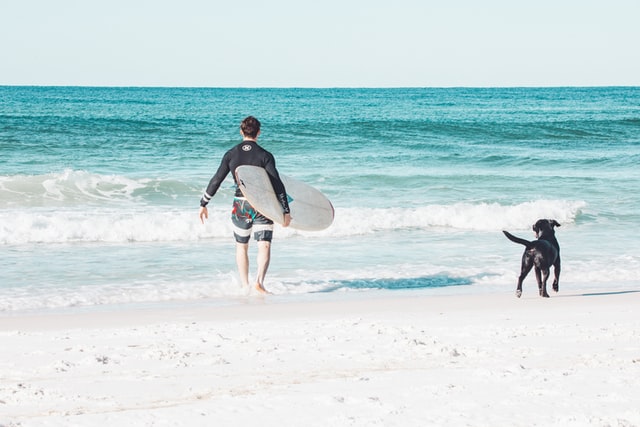
It’s now time to test your training!
Head to a local water body where you can start your SUP adventures with your dog.
Place the board on the water surface at the shallow end. Get down into the water and climb on the board, standing on one knee. Use your other leg to anchor the board in position.
Now command your pup to ‘get on’ the board. You might have to coerce him with some treats. Once he jumps on, ask him to sit or stand while facing you. When he successfully holds this position, reward him with treats.
Next, pull your anchored leg onboard and start rowing with the paddle. In your first go, aim to spend 10 to 15 minutes in the water so both you and your pooch can get the hang of it. Paddle your way back to the edge of the water body and help Fido’ get off.’
You have had your first SUP adventure together!
In the next few trips, learn to paddle while standing and make your pup sit facing away from you.
If there are any accidents and Fido falls into the water, calmly pull him back on board using the handle on his PFD.
Conclusion
If you know how to paddleboard and enjoy your adventures in the open water, there is no reason why your pooch cannot go along on your next one.
Learning to SUP with your dog can seem like a tricky process. However, once you get him comfortable with the paddleboard, the rest of the training follows along easily!
All you need is an inflatable paddleboard of good quality, impressive SUP skills, and a huge bag of treats to help Fido master the paddleboard.
